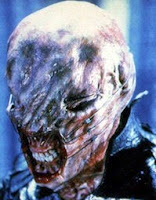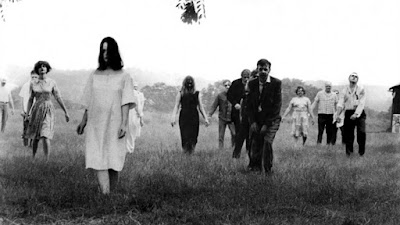COLIN (2008)
DOGHOUSE (2008)
OUTPOST (2008)
BILLED as "The £45 Zombie Movie" and the "First Zombie Movie told from the zombie's perspective” (though RETURN OF THE LIVING DEAD 3 and I, ZOMBIE: THE CHRONICLES OF PAIN portrayed a descent into putrefaction fifteen and ten years previously), Marc Price's COLIN conveys its apocalyptic world through an accompaniment of alarms, gunfire, explosions and screams. This ambience is accompanied by a threadbare electronic soundtrack, which envelopes the eponymous Colin (Alastair Kirton) in his new life as a shambling ghoul. Colin is the most sympathetic screen zombie since Bub (Howard Sherman) in DAY OF THE DEAD - its no coincidence that Colin's girlfriend Laura (Leanne Pammen) works in Sherman's Café - and there is some wonderful black humour: a victim’s ear is removed complete with earphone, and Colin is mugged for his trainers.
DOGHOUSE (2008)
OUTPOST (2008)
The bulk of the £45 budget for COLIN went on tea, coffee and biscuits.
BILLED as "The £45 Zombie Movie" and the "First Zombie Movie told from the zombie's perspective” (though RETURN OF THE LIVING DEAD 3 and I, ZOMBIE: THE CHRONICLES OF PAIN portrayed a descent into putrefaction fifteen and ten years previously), Marc Price's COLIN conveys its apocalyptic world through an accompaniment of alarms, gunfire, explosions and screams. This ambience is accompanied by a threadbare electronic soundtrack, which envelopes the eponymous Colin (Alastair Kirton) in his new life as a shambling ghoul. Colin is the most sympathetic screen zombie since Bub (Howard Sherman) in DAY OF THE DEAD - its no coincidence that Colin's girlfriend Laura (Leanne Pammen) works in Sherman's Café - and there is some wonderful black humour: a victim’s ear is removed complete with earphone, and Colin is mugged for his trainers.
The title star prefers to avoid confrontation, and it is testament to Kirton's virtually silent performance that Colin remains such a pitiful figure with echoes of Karloff's Frankenstein. But many will find COLIN too slow, sombre and uneventful, perhaps missing the human survivor stories we're accustomed to in the sub-genre. The film does find some room for the living, and perhaps ironically it's in these scenes that the film loses its way. The bulk of co-stars cannot compete with Kirton, and it's in the busier, more populated sequences – the street attacks and especially in a house siege – that the DIY nature of the production is most apparent. Unlike most living dead pictures where you relish the gore and the scale of destruction, COLIN instead leaves you with a sense of melancholy.
Z-movie starlet Emily Booth plays The Snipper in DOGHOUSE.
After his own amateur effort EVIL ALIENS, Jake West returns with the immature DOGHOUSE, armed with a budget and the Britflick equivalent of a name cast. It tells the story of a group of men who, leaving behind relationships in varying degrees of dysfunction in London, descend on the rural backwater of Moodley (where women outnumber the men 4 to 1) for a lads weekend. But their destination is filled with ravenous zombirds, or as Neil (Danny Dyer) has it, "an army of pissed-off, man-hating feminist cannibals." There is a genuine revulsion towards woman and their emotional tirade on menkind as we enter an alternate England envisioned by the CARRY ON team or George Best. The zombirds aren't just normal women who have been infected by a military virus, they're Sid James stereotypes; a bride in her underwear, a dominatrix hairdresser et al, and there is even a Hattie Jacques sauce pot. DOGHOUSE is riddled with in-jokes but this isn't flattery so much as smirking, with the director fittingly calling the bus-hire company West Tours.
Away from the Romeroesque COLIN and juvenile DOGHOUSE, Steve Barker's OUTPOST is a robust British zombie movie which focuses on that most interesting sub-genre within a sub-genre: the Nazi undead. Equating the Third Reich with the zombie makes perfect sense, as it is easy to see the brutish automatons of Hitler's Germany as monsters rather than human beings; in fact, there exists a compulsion to dehumanise all our enemies. Arabella Croft and Kieran Parker mortgaged their Glasgow home in order to raise finance for the film, which is a bunker-bound horror where mercenaries (led by DC (Ray Stevenson)) fight against an advancing zombie tide. The Nazi ghouls here are effectively realised, and owe more than a passing debt to the mariners of THE FOG as they torment victims by pushing bullets and bayonets into eyes and mouths. But they also adhere to that particular John Carpenter film in their ambiguousness: are they zombies, ghosts, genetic supermen or a combination of all three?
Nazi zombies haunt the OUTPOST.
The lack of budget doesn’t work against OUTPOST because nearly all of the film takes place in the confines of the bunker, and when the camera does venture outside, it is usually at night preceding a mist-bound attack. The performances are strong, yet the nihilistic tone fittingly tells of a mission for people we never meet, and the characters are never fully realised for the audience to care if anyone does pull through. However, the film has developed enough of a following for a sequel to be announced, OUTPOST II: BLACK SUN, which is currently in pre-production.

































